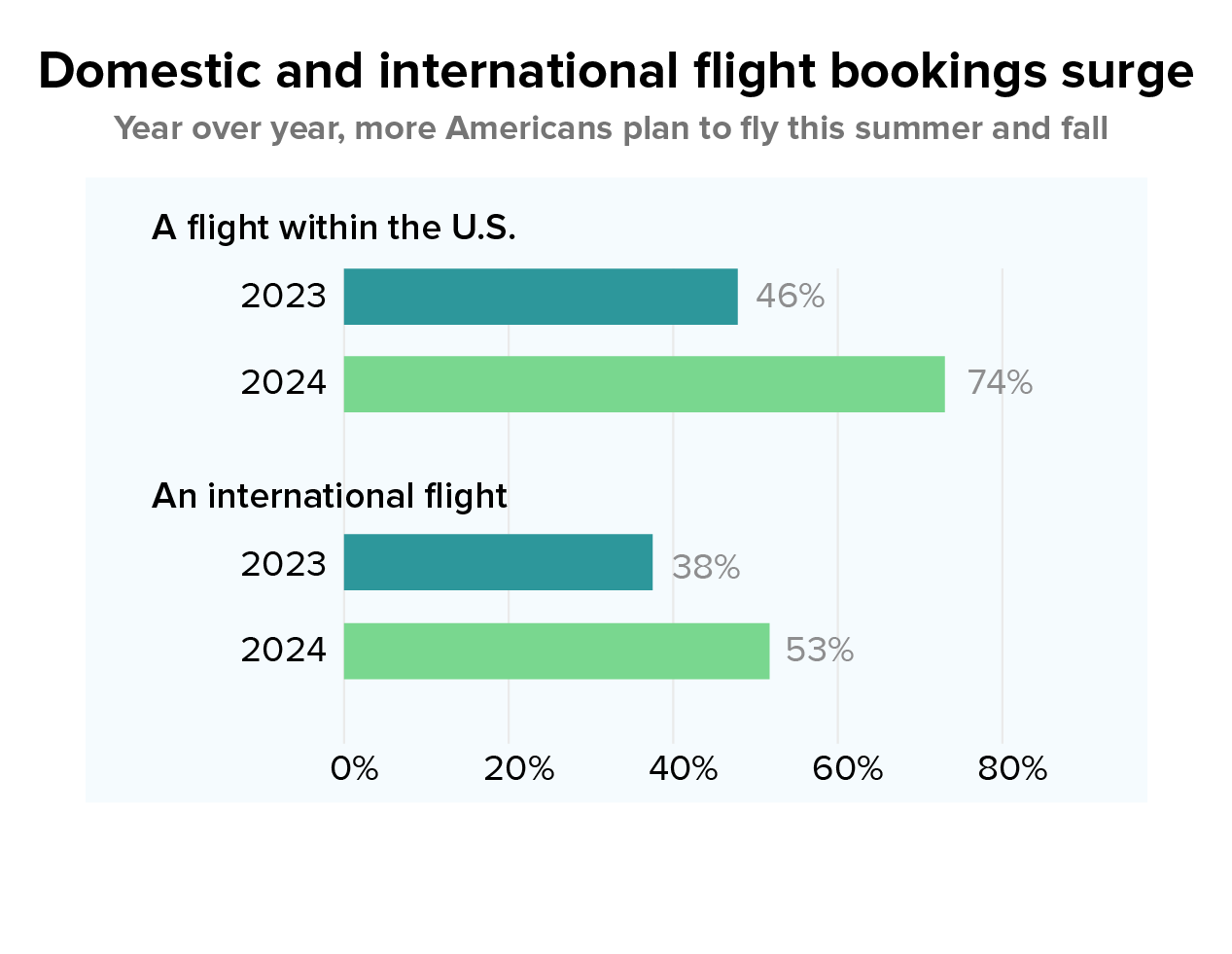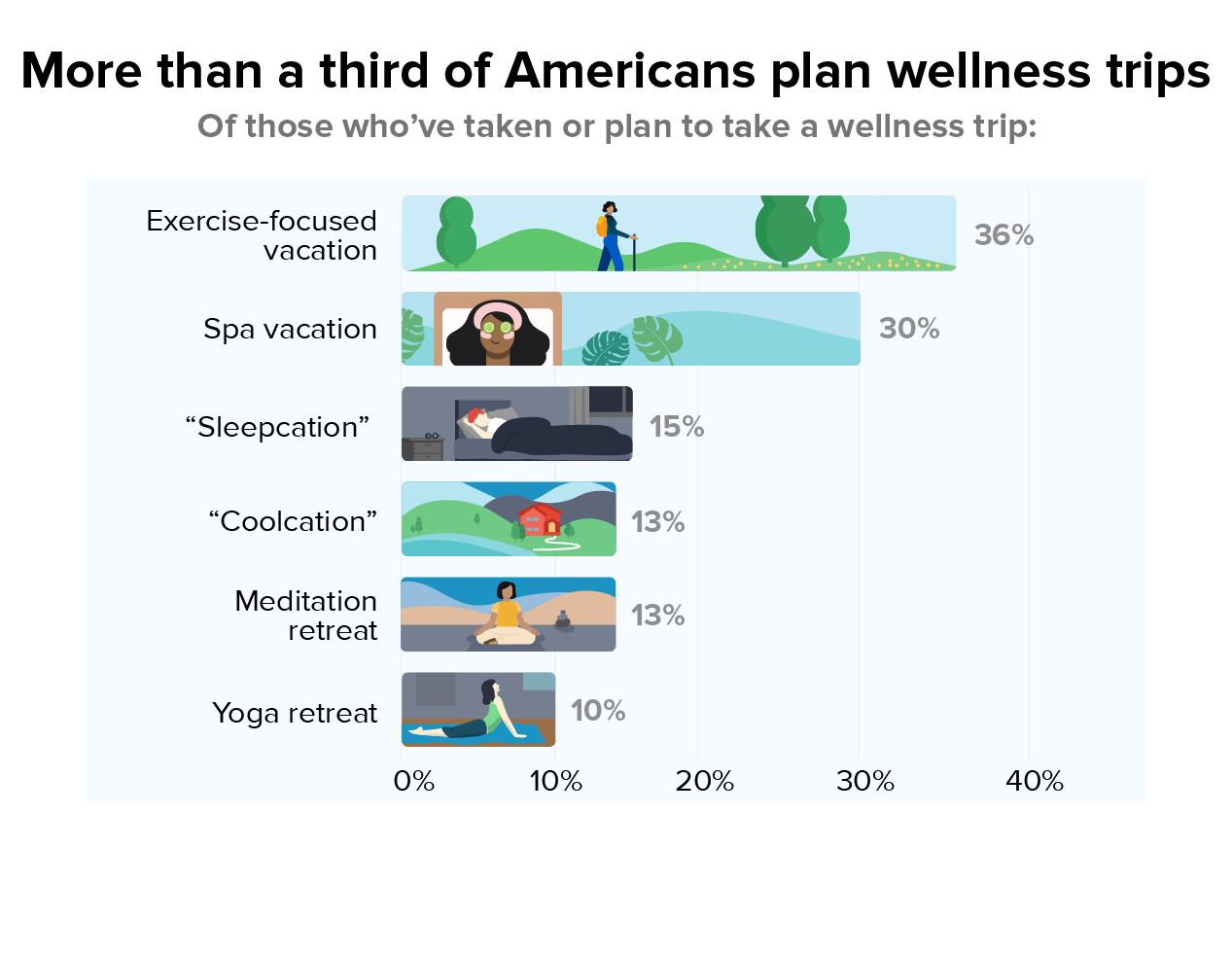
Summertime is upon us. And Americans are ready to spend their sun-drenched days, well, somewhere else.
According to a recent survey of nearly 1,500 U.S.-based TripIt users—who are slightly more inclined to travel than the average American—almost all (90%) respondents took a trip in the past three months: 66% took a domestic flight, 65% stayed in a hotel, 45% took a road trip with a personal car, 37% took an international flight, and 20% stayed in a vacation rental.
And as many travelers have plans in the coming months: 92% of respondents said they’re planning a trip between now and the end of fall. In fact, our data shows both domestic and international flight bookings are up year over year—with increases of 61% and 39%, respectively.

What’s inspiring this surge in flight bookings? And what kinds of trips are Americans taking this year? Keep reading to learn what travelers had to say about traveling internationally, the types of trips they’re planning, plus their experiences traveling so far this year.
One-third of Americans taking more international trips
International flight bookings are up, and so are the number of Americans planning trips abroad. According to our data, more than a third of travelers (34%) said they’re taking more international trips now than they did in the past five years. More than half (55%) said they travel abroad at least once a year.
Of those who travel more now, respondents said they do so because they can better afford international trips (53%); they have more flexibility at work (43%); travel restrictions have eased (40%); and they’re more interested in international trips and destinations (39%).

We know from our research that pop culture is a driving force behind many Americans’ travel plans this year. Our study of pop-culture trips showed that 40% of Americans are planning a trip inspired by pop culture in 2024—an 82% jump from last year!
Take The White Lotus, for example. Season three’s release date has yet to be announced, but travelers are already booking trips to its filming location: Thailand.
Then there’s Taylor Swift’s Eras Tour. The European leg is in full swing, and many Americans plan to be in attendance—thanks to cheaper tickets (and a strong dollar). Kendyl Grender, budget-travel hacking coach, is one of the many who are traveling to see her perform overseas.
“I booked a trip to Amsterdam this summer just for the Eras Tour,” she said. “It’s a cultural phenomenon. There is certainly nothing else like it and probably won't be for a long time.”
But it’s not just musical megastars drawing Americans to Europe this year. A separate TripIt survey revealed nearly a quarter of Americans travel for special sporting events, like the Olympics. More than 15 million people are expected to travel to Paris for the games this summer.
Tip: TripIt’s International Travel Tools gives you embassy info, currency exchange rates, socket and plug requirements, tipping advice, and more. This feature is available on our Android, iOS, and Mac TripIt apps.
Exercise and spa vacations lead wellness trips
Meanwhile, some Americans plan trips around their own exercise regimen. In fact, wellness trips—that is, trips focused on maintaining or improving personal well-being—are an ever-growing travel trend. Our data shows that 35% of Americans have taken or plan to take a wellness trip in the next year.

But what constitutes wellness is evolving: our data shows 13% of wellness trips are coolcations—i.e., trips to destinations with cooler or temperate climates. We anticipate this type of trip to increase in popularity as travelers seek out alternative destinations to ones that are prone to extreme heat.
So, why (else) are Americans taking wellness trips? According to our data, relieving stress (67%); mental restoration (65%); increasing happiness (59%); health (49%); getting a break from work (45%); catching up on sleep (26%); and taking a digital detox (16%) are among the top reasons.
Flight delays down 25% from 2023
Relieving stress may be the top reason for taking a wellness trip, but traveling isn’t always a stress-free experience. Sometimes, plans go awry.
Our data shows that, of those who took a flight in the past three months, one-third (33%) experienced some sort of flight disruption. The most common disruption was a delay of an hour or more; 27% of travelers said this. The good news? The number of travelers reporting delays has actually decreased 25% from data we released last June.
Tip: TripIt Pro Risk Alerts notifies you when a potential disruption may impact your trip—even before they result in a flight delay or cancellation. These proactive alerts keep you in the know, so you can make informed decisions and stay agile as unexpected situations arise.
Of those who experienced disruptions, 89% did not receive any compensation for their disruption. But there’s good news for travelers here, too: Earlier this year, the U.S. Department of Transportation (DOT) issued new rules requiring airlines to automatically refund passengers for flights that are delayed, canceled, or significantly changed, as well as helping protect passengers from surprise junk fees when purchasing a ticket.
When asked, nearly all travelers said they support these new rules: 86% of travelers said they support the new rule that would require airlines to compensate passengers affected by flight cancellations and delays (63% strongly support; 23% somewhat support).
Even more (92%) support the new rule that would require airlines to disclose fees upfront (79% strongly support; 13% somewhat support). One possible reason for the extra support? More than half (59%) of travelers said they have been surprised by additional fees after purchasing their tickets.
Whether motivated by pop culture, wellness and sporting events, or cooler temps, Americans have an appetite for experiences they can’t get at home. Coupled with more affordability, flexibility—and passenger protections—we anticipate interest in international travel to only grow.
Methodology: TripIt surveyed nearly 1,500 U.S.-based users to understand their past and upcoming travel plans, plus their priorities, preferences, and behaviors regarding travel and travel planning. The survey took place May 20-29, 2024.

